How Do You Feel When You Look Outside the Window and Its Raining Again
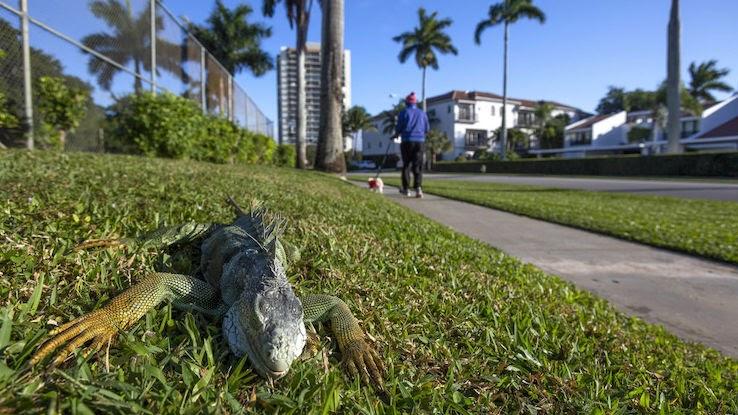
If you lot're looking to accept a myth debunked, you lot've come up to the incorrect place. "Frozen Iguanas Falling From Florida Trees" is neither the name of a schlocky B-rated horror film nor an urban legend. Information technology's something that really happens, which, if you're a Floridian yourself, you might exist somewhat familiar with. Just the residual of united states may merely be getting used to the fact that information technology rains more than cats and dogs in The Sunshine State. In add-on to hurricanes and alligators, there's some other form of reptilian precipitation to watch out for.
But merely why does this phenomenon happen? The short answer is that iguanas simply don't belong in Florida; they're not native to the land, and those living there aren't used to the extremes of Florida weather yet. But there's a longer answer, and it's a fascinating tale of invasive species, animal physiology and one of the strangest weather reports yous'll ever see.
Iguanas Are Common cold-Blooded, Which Induces Lethargy
When a creature is cold-blooded, its body temperature changes forth with shifts in the ambient temperature that occur in the air effectually the animal. This lies in dissimilarity to warm-blooded animals, which are able to maintain internal body temperatures higher than those of their surroundings due to their differing metabolic processes. Snakes, crocodiles, alligators, turtles and lizards, all of which are reptiles, are generally cold-blooded. When temperatures around them drop, and then does their internal temperature. This process also happens to iguanas — fifty-fifty the iguanas that call Florida home.
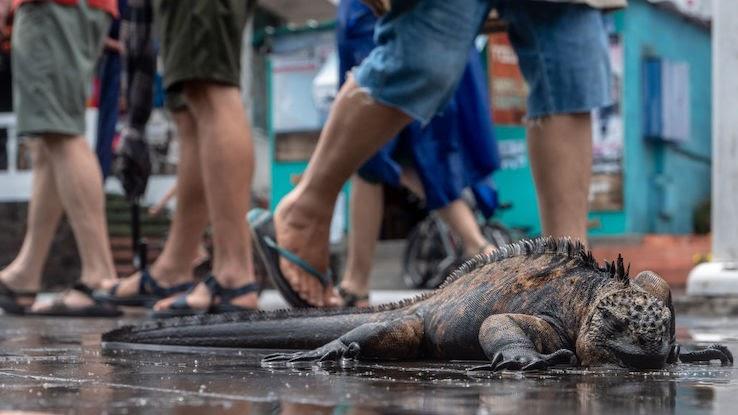
As the temperature in the air — and, thus, the iguanas' blood — drops, they get increasingly inactive. When external temps accomplish about 45 degrees Fahrenheit, iguanas exposed to these weather enter a stunned or fallow state. They'll gradually get so sluggish and and so immobilized that they may look dead — only aren't. These lethargic lizards are actually withal animate, and all their bodily functions are standing. Just those functions are taking identify much more than slowly considering the iguanas' blood is moving around their bodies at a profoundly reduced charge per unit.
That said, if it stays in the 40s longer than eight hours, those persistent cold temperatures can get fatal to iguanas. But simply how cold does information technology take to be to trigger lethargic responses? That depends. Ron Magill, Zoo Miami's communications director, told CNN, "The temperature threshold for when iguanas begin to go into a dormant state depends greatly on the size of the iguana… More often than not speaking, the larger the iguana, the more cold it tin tolerate for longer periods." That may accept to do with the fact that the larger lizards have more claret in their bodies so they can retain warmth in their blood a fleck longer than the smaller reptiles.
The Lizards Are Diurnal — and They Have Unconventional Sleeping Spots
There may not exist many things that people and iguanas have in mutual, but the period of time when they're awake each mean solar day is one. Diurnal animals like iguanas are active during daylight hours and inactive at night when they slumber or rest. Because iguanas are already irksome or sleeping at dark when temperatures are most likely to attain their lowest points, that's when iguanas are about vulnerable to the sluggishness-inducing effects of a common cold snap. The nighttime temperatures and the cold ambient temperatures compound.
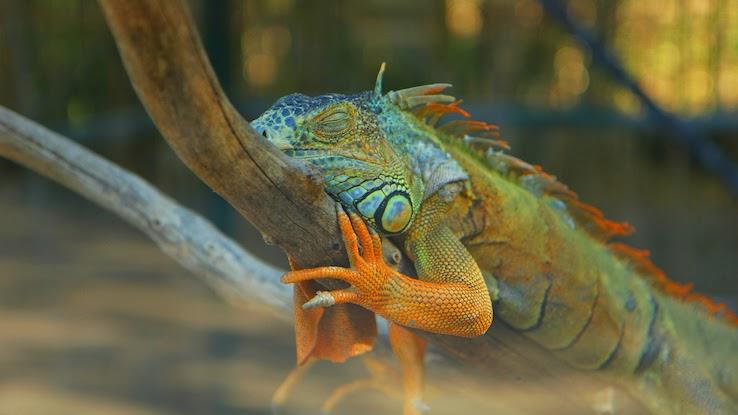
At that place's one more than thing almost iguanas' diurnal nature to know well-nigh, though. Information technology's where they tend to sleep that matters — and that leads to "iguana pelting." Iguanas typically wander the ground or stay slightly secluded in brushy areas during the day. But they then sleep upward in the relative safety of tree branches.
A typical slumbering iguana is perfectly capable of remaining safe and secure in a tree until morning. However, when iguanas are rendered lethargic or asleep by cold temperatures, their immobility causes them to lose their grip on the branches. Iguanas that succumb to the coldest overnight temperatures in Florida only fall out of bed — and onto the ground to be establish by startled Floridians when the sun rises.
They're Invasive and Aren't Suited for Florida's Climate
One might think that iguanas would've evolved to bargain with Florida's temperatures without going through this issue — they're native to rainforests, after all. But even if that were ordinarily the example, there are a few factors working against iguanas in this regard.
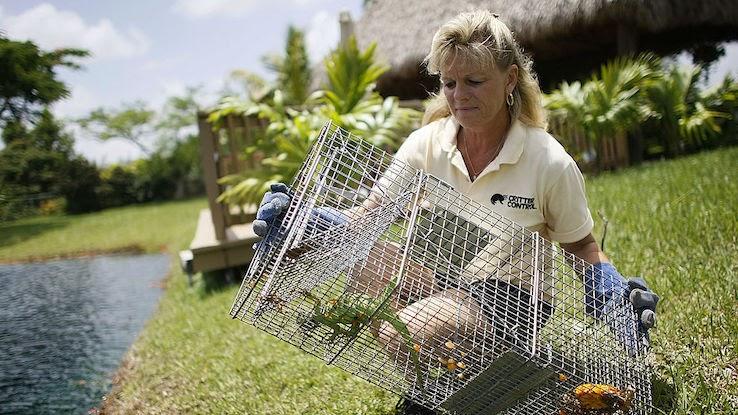
First, temperatures depression enough to trigger this consequence are pretty uncommon in Florida, so the lizards aren't exposed to these dips often enough to develop any kind of evolutionary response. Depression lows happen occasionally — it'south often January when they do occur — merely Florida temperatures in the 40s are by far the exception rather than the dominion.
While Florida does have a minor number of native iguana species, the vast majority of these lizards in Florida — including the virtually common green iguana, a species that's helpfully named Iguana iguana — aren't native to Florida at all. They're actually invasive, so they haven't adapted to the land's (very) occasional chilly weather condition.
According to the Florida Fish and Wild fauna Conservation Committee, there are over 40 non-native iguanas and relatives calling The Sunshine Country domicile. These transplants were introduced to Florida as a result of the pet trade. In 1995 solitary, over 800,000 green iguanas were imported into the Usa from their native homelands — much warmer countries similar Honduras, El salvador, Panama and Colombia. Over fourth dimension, so many iguanas escaped or were released by pet owners into the wild that they established a presence throughout the land.
No, That Iguana Is (Probably) Not Dead
In most cases, an iguana that you might find lying on the ground nether a tree outset matter in the morning time isn't dead and won't dice from the cold snap. Rather, it's simply immobilized or comatose due to the cold. As the temperatures increase around the iguana and it's exposed to sunshine, the iguana's blood temperature will increase, as well.
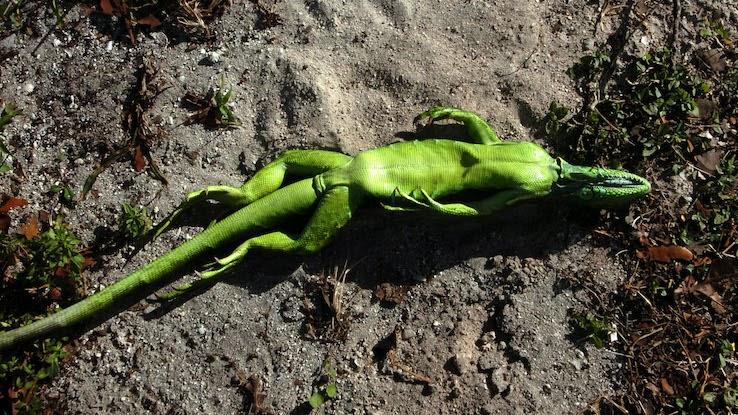
Gradually, the iguana volition go more energetic and scamper away. As the Miami Zoo's communications director mentioned, though, very cold temperatures tin can kill modest iguanas, but many simply shake off the cold (and any falls from trees) with the inflow of warmer temperatures and sunshine.
With this in mind, information technology probably won't be so startling side by side time you hear about conditions forecasts — aye, the Miami National Weather Service has issued them before — for raining iguanas in Florida. In addition to having the benefit of this general introduction to the reptile-related implications of cold snaps, though, you can sometimes count on Florida weather forecasters to requite you all the information y'all need fifty-fifty if some of it is definitely not information you want. (Check out this story most a Florida weather forecast that went manner across the probability of precipitation, humidity and expected high and low temps.)
Then, if you lot ever should hear the telltale slap of an iguana hitting the basis in the cool temperatures of a January Florida night, don't exist alarmed. Iguana rain is normal. Weird, but normal.
Source: https://www.reference.com/science/why-rain-iguanas-florida?utm_content=params%3Ao%3D740005%26ad%3DdirN%26qo%3DserpIndex
0 Response to "How Do You Feel When You Look Outside the Window and Its Raining Again"
Post a Comment